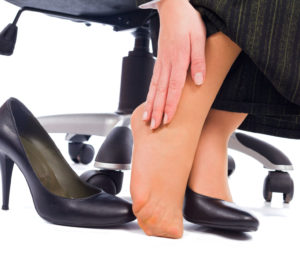 If you notice a small bump on the back part of your heel, odds are you’re dealing with what’s commonly referred to as a “pump bump.” The name comes from the pump-style heels that often contribute to the onset of the condition, but heels aren’t the only type of shoes that lead to pump bumps. Below, we take a closer look at pump bumps, the symptoms they can cause, and how they are treated.
If you notice a small bump on the back part of your heel, odds are you’re dealing with what’s commonly referred to as a “pump bump.” The name comes from the pump-style heels that often contribute to the onset of the condition, but heels aren’t the only type of shoes that lead to pump bumps. Below, we take a closer look at pump bumps, the symptoms they can cause, and how they are treated.
Causes and Symptoms of Pump Bumps
You’re probably more familiar with the term pump bump, but the medical name for the condition is called Haglund’s Deformity. As we noted above, it is categorized by the formation of a bony lump on the bony part of the heel near where the Achilles tendon runs. Pump bumps can be asymptomatic, or they can cause significant discomfort.
Pump bumps are often caused by wearing tight, ill-fitting shoes, and continuing to wear these footwear options will only lead to an increase in symptoms or bump size. Sometimes acute trauma can contribute to the onset of a pump bump, but poor footwear choice is the main culprit.
Symptoms of a pump bump include:
- Visible bump on the back of your heel
- Mild to moderate pain or discomfort
- Difficulty fitting into shoes that once fit
- Discomfort that increases with activity
Diagnosis and Treatment of Pump Bumps
Minor to mild pump bumps can typically be diagnosed and treated by the patient without the need for specialist intervention. Because the condition is visible to the naked eye, you’ll be able to diagnose a pump bump just by examining the back of your heel and seeing if you are experiencing any of the symptoms listed above. Early stage pump bumps can be treated by switching to comfortable, looser fitting shoe options and by limiting intense activity. Some people also find success by putting cotton balls or extra padding on their heel when inserted into a shoe to give the area a little more protection from pressure.
Now, just because a number of pump bumps can be treated without seeing a specialist, it doesn’t mean that a specialist isn’t your best option, especially if you have a very pronounced bump or are dealing with significant pain. Your doctor will take a closer look at the bump, ask about your symptoms, and get a detailed look at the growth with the assistance of an X-ray.
If conservative care doesn’t fix the problem, surgery may be necessary. Surgery involves making a small incision next to the bump while avoiding nearby nerves and tendons. This incision will allow the doctor to view the bony growth, as well as a fluid-filled bursa sac that usually develops due to the friction on the bony prominence. The bursa sac is drained and the bone is resectioned down to an appropriate level. In some cases, a substance known as bone wax is administered to help prevent the regrowth of the pump bump. The incision site is then closed, and the patient is given some weight-bearing restrictions to follow for the next 4-6 weeks.